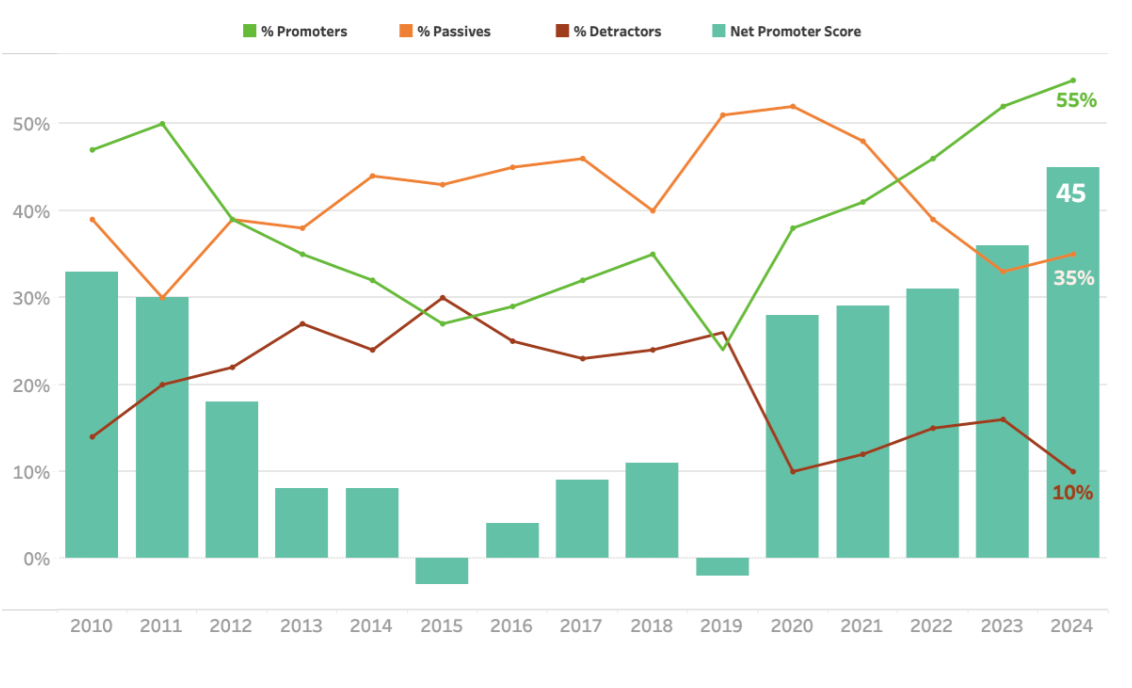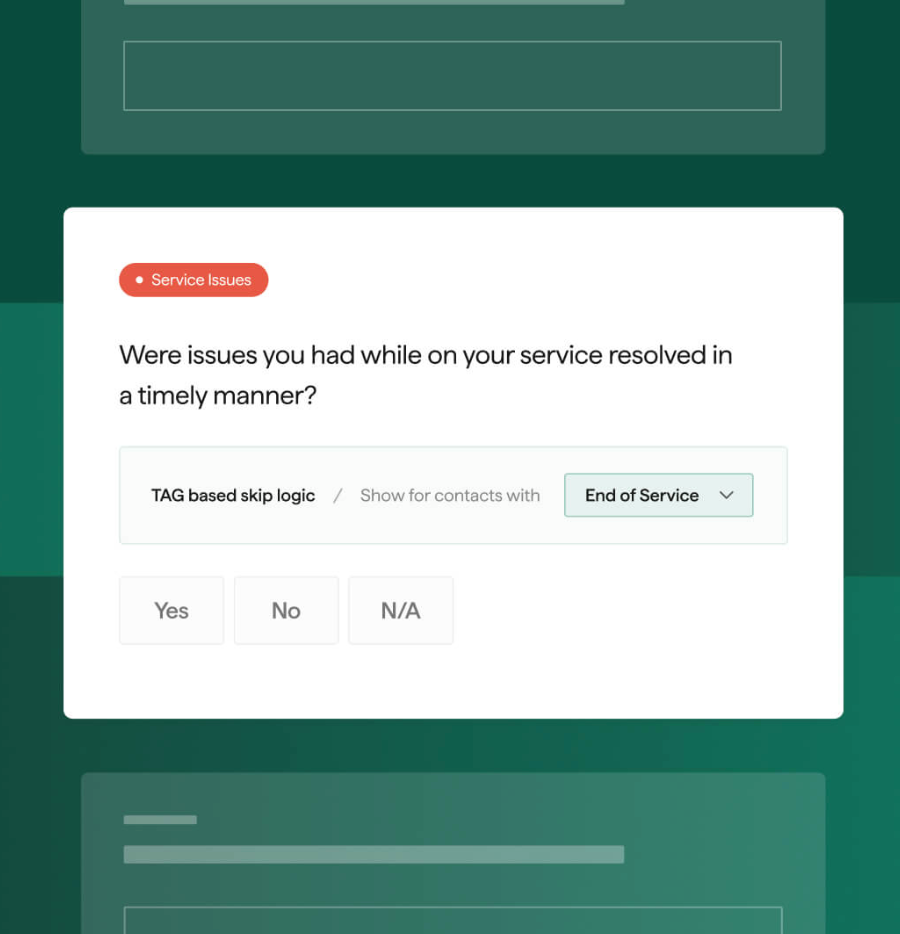Maximizing the ROI of Your Staffing Firm’s Client Experience Using ClearlyRated

- ROI in staffing includes satisfaction, retention, and reputation that drive lasting success.
- But measuring staffing ROI can be tricky, with attribution gaps, time lags, and the constant balance between quick wins and lasting relationships.
- Feedback helps close this gap by turning client and candidate insights into measurable outcomes through platforms like ClearlyRated.
- When staffing firms act on that feedback, they can witness a 40% boost in client retention and 25% higher repeat placements.
When you talk about ROI in staffing agencies, it can mean wildly different things to different people. Some only think about placements, but the real picture includes costs, retention, loyalty, and your firm’s reputation. If you're only measuring how fast roles are filled, you’re missing every other moment that matters to your clients. The smartest staffing leaders now track staffing ROI metrics that go far beyond hiring speed or recruiter output.
Today’s clients expect support, strategy, and strong results even when budgets are tight and plans shift overnight. That’s precisely why recruitment ROI must include service quality, feedback, and client retention, in addition to hiring activity.
When buyers and candidates are facing economic pressure, the experience you provide becomes a deciding factor in whether they stay with your firm or start looking elsewhere. According to our 2025 Staffing Buyer Insights Report, 78% of buyers are already considering salary adjustments, and 74% are expecting to outsource more job functions. This shift is happening while 61% predict or are already entering a full hiring freeze.
With rising client expectations and growing uncertainty, understanding how to measure staffing ROI becomes the key to sustainable client partnerships. In this article, we’ll explore how to use ClearlyRated to measure, improve, and maximize the ROI of your staffing firm’s client experience.
Key Components/Metrics of Staffing ROI
In staffing, you need to understand how costs, time, quality, and revenue work together to create value. Let’s break down the main types of metrics that help you measure ROI in staffing and guide smarter decisions.
These include:
1. Cost-related metrics
Costs matter deeply because they directly affect your profitability and client satisfaction. Knowing exactly where your money goes helps you control expenses and improve your staffing ROI metrics. Here are the critical cost-related metrics:
- Cost per hire: This measures the total spending on recruiting and onboarding each candidate, including advertising, interviews, and training.
- Cost of vacancy: This refers to the lost revenue or productivity that occurs when a client’s position remains unfilled, which can quickly add up.
- Sourcing costs: Expenses tied to finding candidates, such as fees for job boards, staffing platforms, or external recruiters.
- Onboarding costs: The resources spent to bring new hires up to speed so they can perform effectively in their roles.
Clients feel the pinch of these costs, especially when economic conditions tighten.
2. Time metrics
Time is money in staffing. How long it takes to fill roles and how quickly new hires become productive affect both your firm’s staffing ROI and your client’s business outcomes.
These metrics focus on speed and efficiency:
- Time to fill: The number of days it takes from the job posting to a candidate accepting the role. Faster time to fill means less downtime and happier clients.
- Time to productivity: This metric measures how quickly new hires reach full productivity, which in turn impacts the client’s ability to meet their targets more efficiently.
When clients see roles filled quickly and new hires performing sooner, they view your firm as reliable and effective. In uncertain economies, like today’s, where 74% of buyers expect more outsourcing, speeding up these times can make a significant difference in client retention and satisfaction.
3. Quality metrics
Quality shapes the long-term success of your placements and your staffing firm’s reputation. Many clients report that poor candidate fit is their biggest frustration.
These metrics focus on satisfaction and performance from all sides:
- Retention of placed candidates: This tracks how long candidates stay with the client, showing the lasting value of your placements
- Client satisfaction: Measures how well your firm meets or exceeds client expectations through surveys or feedback tools for staffing firms
- Candidate experience: Reflects how candidates perceive your recruitment process, which impacts your brand and future talent pool
- Performance on the job: Evaluates whether candidates meet or exceed the requirements of their roles once hired
Nearly half of clients report placements that fail to meet expectations, which drastically drops satisfaction scores from 53 to just 29 on the NPS scale. Focusing on quality metrics protects your firm from high churn rates and builds stronger long-term partnerships.
4. Revenue metrics (for agencies)
Revenue metrics reveal the financial strength of your staffing firm and how well you monetize your services. Tracking revenue streams and profit margins helps identify growth opportunities:
- Margin per placement: The profit earned after covering costs for each candidate you place. Higher margins mean better ROI in staffing.
- Recurring/contract staffing revenue: Income from ongoing contracts provides a steady cash flow and builds firm stability.
- Cross-sell/upsell: Revenue generated by expanding services to existing clients helps grow your business without needing new customers.
Our data indicate that firms that track both revenue metrics and client satisfaction are more likely to achieve sustainable growth. In a market where staffing clients consider salary adjustments, maintaining strong margins while meeting client needs is essential to avoid customer churn.
Challenges in Measuring Staffing ROI
It’s not always easy to link your efforts to clear outcomes, especially when the impact of those efforts shows up months later. These challenges can slow down decision-making, and worse, lead you to invest in the wrong things.
Attribution issues
You might invest in employer branding, source aggressively, or focus on candidate experience, yet you cannot always trace which action drove the results your client cares about most. Overlapping touchpoints make it unclear whether branding, sourcing channel, or recruiter effort contributed to the success. When 31% of fast-growth agencies in 2025 report that the quality of hire ranks above cost-per-hire or time-to-fill as their top metric, it shows a belief in deeper causes rather than just surface metrics.
Unless you have feedback tools for staffing firms that map every key moment in client and candidate interactions, you lose clarity.
Time lags
Some of the most important signs of success, such as retention or candidate performance, may not become apparent for weeks or even months. For example, retention doesn’t reveal itself immediately, as it usually takes months to determine whether a placed candidate truly fits.
Client satisfaction can also shift unexpectedly, especially if something goes wrong after placement, which can completely change how a client feels about your firm. Even employee sentiment, captured through eNPS, is constantly shifting and can drop quickly if communication falters or workloads become unmanageable.
Our data indicates that 78% of staffing buyers now consider economic pressure to be a serious concern. That makes it even more critical to monitor long-term performance and retention metrics, especially when hiring freezes or downsizing may mask deeper issues. If you only focus on short-term wins, you could easily be blindsided by unexpected turnover or poor long-term fit.
Balancing short-term and long-term ROI
When you prioritize quick wins, such as faster fills or lower costs, you risk harming reputation, satisfaction, or loyalty in the long run. Many firms today feel pressure to deliver an immediate return, even as clients are becoming more risk-averse and more sensitive to the quality of their experience.
If you only care about what you see this quarter, you might miss what matters next year. Balancing short-term and long-term ROI requires intentional metric design, frequent feedback loops, and readiness to act on both immediate and delayed signals, so that ROI in staffing becomes both reliable and meaningful.
How Feedback and Satisfaction Fit into ROI
Feedback and satisfaction directly influence staffing ROI by shaping client loyalty, candidate acceptance, and long-term growth. Understanding these connections helps firms use staffing ROI metrics more effectively to improve retention.
The role of candidate experience
When candidates feel valued throughout the hiring process, they accept offers more often and refer others, boosting recruitment ROI. Positive experiences lead to stronger retention, while poor candidate fit and communication gaps reduce placement success.
This cycle affects staffing ROI because it impacts both client satisfaction and the recruiter’s ability to fill future roles more efficiently.
The role of client satisfaction
Client satisfaction shapes how often contracts renew and whether firms win additional business. Our 2025 Staffing Buyers Insights Report found that 44% of clients experienced placements that missed expectations, while 36% reported poor communication or unexpected talent turnover.
Satisfied clients provide testimonials, helping firms earn prestigious awards and build a strong reputation that attracts new business.
The role of feedback signals
Silence from a client is rarely a sign of satisfaction, and disengagement often starts long before contracts end. Fewer replies, smaller order volumes, or lack of interest in meetings are all signs that shouldn't be ignored.
Net promoter scores (NPS), client testimonials, and industry-tailored surveys help you track real-time sentiment, identify recurring problems, and act before clients walk away. In fact, our 2024 NPS Benchmarks for the Staffing Industry suggest that client NPS rose from 36 to 45, driven by faster issue resolution and a better placement fit. But with top-performing industries crossing 50, staffing still has work to do.


Regular feedback helps close that gap by highlighting weak points and validating wins. With actionable insights, your team can make informed decisions and protect client relationships.
How to Improve ROI in Staffing Using Tools Like ClearlyRated
To turn feedback into meaningful ROI in staffing, you need tools that let you listen, act, and grow with clarity. At ClearlyRated, we help you capture insights across clients and candidates to drive revenue, loyalty, and reputation.
Below are ways our platform empowers you to strengthen ROI in staffing firms through feedback.
Getting the right feedback
To generate useful metrics, you must gather feedback consistently, at the right moments, and from every stakeholder. Hence, we send client surveys immediately after placements, regularly during contract life, and at key renewal intervals so you can detect early warning signs.

We also deploy talent surveys at key stages, including interview completion, onboarding, and post-placement performance, to track satisfaction and retention drivers. Because we automate survey delivery, you avoid manual work and maintain high response rates. With this multi-stakeholder feedback approach, you gain a more accurate picture of where your revenue is at risk or where growth opportunities exist.
Turning feedback into action
Collecting data is only the start. Improving your ROI demands closing the loop with swift, targeted action. When a client signals frustration or a candidate flags an issue, we notify your team immediately so you can address concerns before they worsen.
Over time, you’ll notice patterns, such as communication delays or technical hiccups, that cause dissatisfaction, and you can address them systematically.
Driving sales, referrals, and retention
Feedback is your strategic asset for growth when used correctly. Satisfied clients become renewal opportunities, sources of referrals, and receptive buyers for upsells or cross‑sales. Using our platform, you can flag “promoter” clients and candidates and target them with referral campaigns or case studies. That helps you amplify your recruitment ROI beyond immediate placements.
At the same time, showing that you listen and act shows a deeper level of trust. Strong candidate feedback also fuels your employer branding, positioning your agency as a high-care, high-integrity organization in the marketplace. This helps you win better clients and attract top talent.
Using public proof to drive brand visibility
Public validation turns feedback into marketing fuel that drives prospect trust. With us, 48% of clients choose to share a testimonial, and we make it seamless to request, collect, and publish those quotes. You can embed them in your website, proposals, and social media without manual effort.
Moreover, our Best of Staffing awards provide third‑party credibility you can showcase prominently. We also power visible company profiles, of which 77% appear on the first page of local search results, displaying your awards, client reviews, and recruiter bios. These assets help prospects verify your reputation quickly and often accelerate decision cycles.
ROI Implementation and Best Practices
Improving staffing ROI begins with consistent measurement and small, focused steps that lead to long-term results. Here’s how to start:
- Set up baseline metrics: Start by identifying your current cost per hire, time to fill, client satisfaction, and candidate feedback scores. These benchmarks help you compare future results and prove improvements with real data.
- Choose the right feedback approach and tool: Use a platform that allows you to send surveys to both placed candidates and active clients. Include proven metrics like NPS and benchmark your results against industry averages for context.
- Measure incremental gains: Track metrics like lower turnover, fewer open vacancies, and increases in client renewals or referrals. These are signs your feedback efforts are paying off.
- Monitor and iterate: The best firms don’t stop after one round of feedback. Continue to check in, spot patterns, and make small improvements that accumulate over time.
Real Results: Case Studies & Data Points with ClearlyRated
Many firms find themselves asking, 'Do CX surveys actually make a difference, or are they just another task on the to-do list?'
The data and real stories we’ve gathered at ClearlyRated provide a clear answer: nearly 98 % of staffing firms that survey with us report a positive ROI. Sixty-five percent of these firms identify at-risk accounts early through feedback, which helps them act before problems escalate.
For example, when ABR Employment Services adopted our feedback tools, they used the insights to refine candidate touchpoints, standardize processes, and adjust communication frequency. Over the course of twelve months, their NPS rose from 66.7% to 88%, they eliminated detractors, and 51% of their new business came from new clients.
“Everything we do supports a higher purpose,” Brad Johnson, ABR’s newly appointed President, stated. “Our profits help sustain Forward Service Corporation in case of budget cuts or grant reductions. It ties us back to our whole mission of giving back to the community."
Through our collaboration, ABR also won the Best of Staffing awards in both client and talent categories, which, in turn, improved their reputation and fueled further growth.
Unlocking True Staffing ROI with Feedback
Staffing ROI is multi-dimensional and includes cost, quality, satisfaction, and reputation. Feedback tools designed specifically for staffing, like ClearlyRated, give you the power to collect meaningful insights and take action that drives real results.
If you haven't yet audited your current metrics or started a feedback program, now is the perfect time. Even a single feedback initiative can reveal valuable opportunities and risks, helping you stay ahead in a competitive market.
Curious how your firm stacks up? Get started today and see how we can help staffing firms like yours reduce turnover, improve satisfaction, and grow their business.
FAQs
What metrics matter most for staffing ROI, and why?
The most important metrics for staffing ROI include cost per hire, time to fill, retention rates, and satisfaction scores, which measure both financial efficiency and quality.
How much can feedback tools improve retention, client satisfaction, and revenue?
Feedback tools can significantly improve retention and satisfaction by identifying issues early. This leads to stronger client relationships and increased revenue over time.
How to ensure feedback is acted upon (closing the feedback loop)?
To close the feedback loop, communicate results transparently, implement changes quickly, and follow up with stakeholders. Our platform provides actionable insights and support to help staffing firms turn feedback into real improvements.
What is the cost vs benefit trade-off of adding those tools?
While adding feedback tools requires an investment, the benefits far outweigh the costs. Our platform delivers ROI by reducing turnover, improving client loyalty, and driving business growth through timely insights and efficient processes.
FAQs


%5B1%5D.webp)






.png)









_%20The%20Ultimate%20Guide.png)





.png)




















%20in%20the%20Workplace.png)










.png)

%20and%20how%20can%20you%20increase%20it.png)
_%20A%20Step-by-Step%20Guide.png)

.png)
.png)




_.png)



%20in%202028.png)


_%20The%20Ultimate%20Guide%20(2024).png)
















